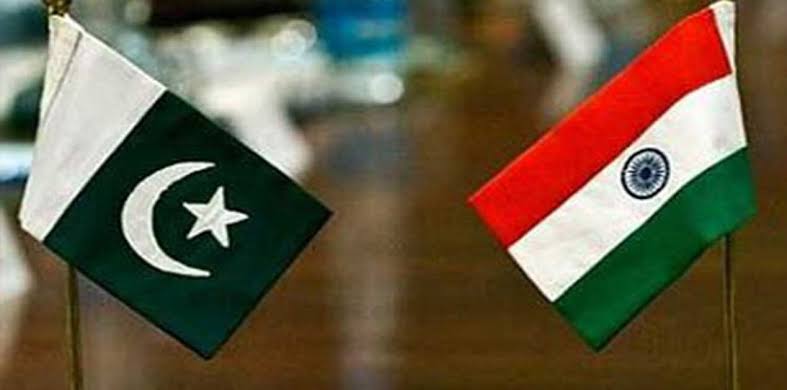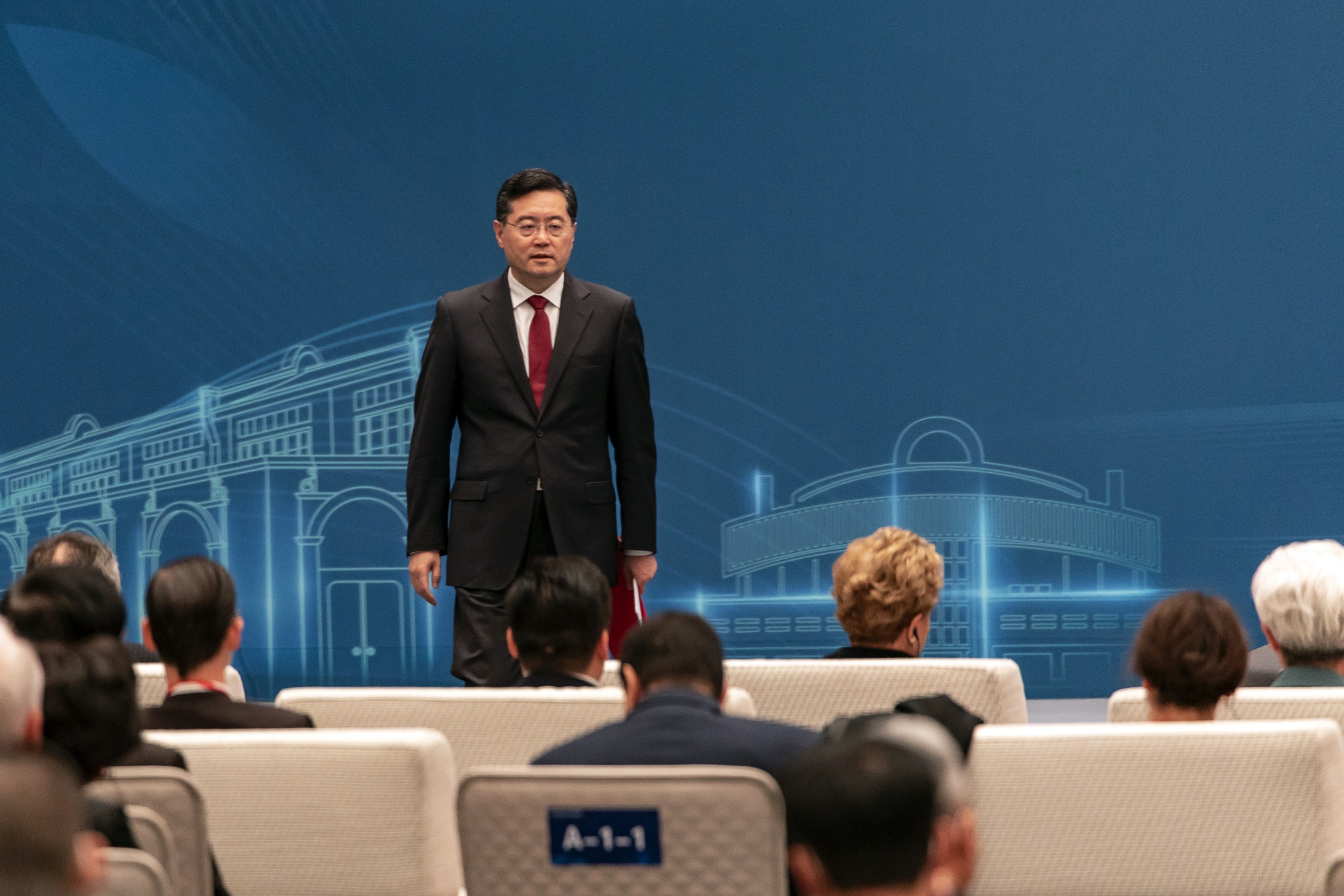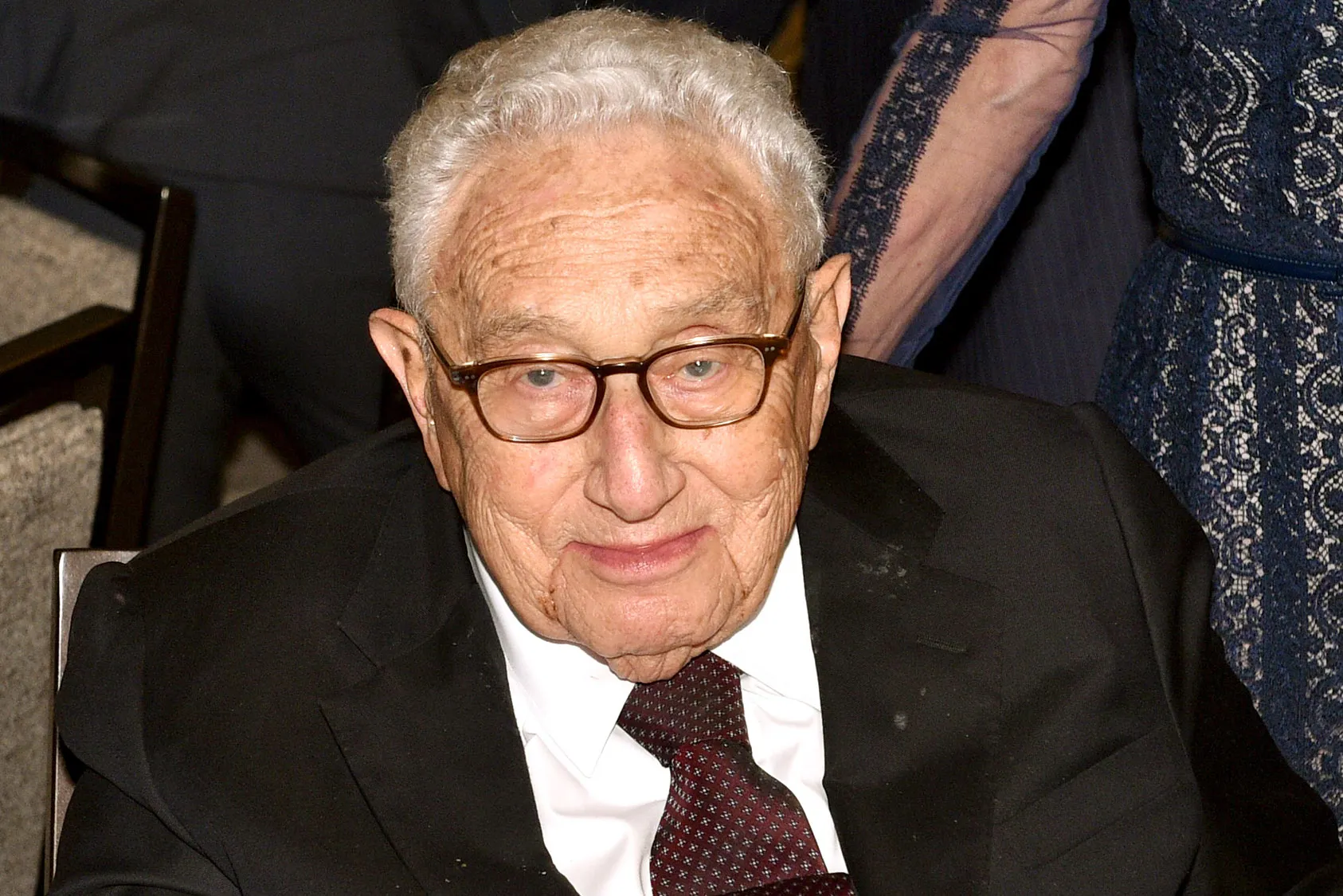Diplomacy
Indo-Pak Stalmate & The Kashmir

 The relations between India and Pakistan have always experienced the Low and High degrees with later offering strategic dialogue with full support from the People of Pakistan while the former remained aggressive showing utmost hostility and acrimony due to extremist forces within their country. The arch-rival India has never trusted Pakistan despite assurances and this mistrust has affected their bilateral relations given the existing circumstances.
The relations between India and Pakistan have always experienced the Low and High degrees with later offering strategic dialogue with full support from the People of Pakistan while the former remained aggressive showing utmost hostility and acrimony due to extremist forces within their country. The arch-rival India has never trusted Pakistan despite assurances and this mistrust has affected their bilateral relations given the existing circumstances.
The terrorism is yet another key problem that has crippled the economy of Pakistan as Pakistan has given countless sacrifices by fighting the Afghan war at the behest of America.
With extensive relations with the world especially Pakistan’s best friend China, India’s atrocities in Indian occupied Kashmir have been intensified with the passage of time. The use of Chemical weapons and widespread human rights violations, defying the UN resolutions on Kashmir valley demanding a plebiscite, the Indian aggression has infinite boundaries.
Even Indian nefarious design did not stop here; they are planning to alter the article 35A of Indian Constitution to change the status of the State of Kashmir in a bid to change the disputed status of the territory. There are widespread protests in Jammu Kashmir against such move and the leaders of Kashmir Freedom movement are either detained or put on house arrest. The Indian Supreme court is hearing the case.
The constitutional provision of article 35A does not allow people from outside the state to buy or own immovable property, seeking permanent residence, avail any state-funded scholarships or get the government jobs. It also gives power to the state legislature to define “permanent” residents. Historically, the Article 35A was added by a Presidential order to Article 370, in 1954 that applied the independent status to the state of Jammu and Kashmir.
Recently, a Delhi-based NGO “We the Citizens” had filed the petition in the Supreme Court of India challenging the articles 35A and 370. The application argued that the above-mentioned articles were discriminatory towards the citizens from the rest of India. The Chairman Peoples Democratic Party (PDP) and Former Chief Minister of State of Jammu and Kashmir Mehbooba Mufti has warned the Indian Government that any tinkering with the aforesaid articles will result igniting violence in the valley that will be beyond the control of the security agencies.
The people of Azad Jammu and Kashmir also condemned this move and demanded from the world community to intervene and exert their pressure on India to back out from such tampering with the said provision of the Indian constitution. The Islamabad’s policy statement sent a strong message to New Delhi to refrain from such the move as Pakistan will raise this issue at UN and other International forums to win support of the world community to force India change it’s desperate trying to abrogate the articles 35A and 370 which lay the basis of Disputed Territory and stops the outsiders from buying the immovable property or seeking citizenship to turn the Muslim majority into minority through temporary settlements that may weaken the claims of Pakistan on the claims of Muslim majority as per the Independence plan of 1947.
Pakistan has always fought a defensive war be it 1965, 1971 the fall of Dhaka, Kargil war and the subsequent heated war of words and the indiscriminate firing incidents on the Line of Control from the Indian side, resulting loss of civilians lives. Though Pakistan retaliates strongly yet Indians are the first to offend and harming the peace process .
The Political leadership remained divided over building close relations with India to maintain peace in the region. Both PPP and PML-N tried to have close relations with India and start the strategic dialogue with India and signed Confidence-building measures. PPP government remained close to Rajiv and Indira Gandhi’s Indian National Congress Government while PML-N leadership maintained close relations with BJP. Though both countries started the peace talks at Foreign Secretary level but given strong the pressure from militant or extremist forces, it was always India who cancelled the peace talks at the eleventh hour giving no solid reasons of such cancellation or rolling up dialogue process.
The blame game for internal involvement has brought them too far but the meaningful dialogue can bring them together once again. The great nations always settle their disputes through negotiation table as wars always bring misery to people and the destruction that takes years to rebuild the country’s infrastructure.
Both the Nuclear capable countries must think sensibly and restart the strategic dialogue to find a solution to the Kashmir problem and end the long rivalry that has created distrust and prompts them to have heavy defence budget rather than focusing on other sectors such as infrastructural development, Education, Health, trade, commerce, IT and Sports.
It is ironic that the enmity as has also gripped the cricket and the fans are disappointed due to the refusal of India playing the series with Pakistan within India and Pakistan or at the neutral venue such as UAE. Sporting events bring the people together and play a pivot role in the normalization of circumstances but regrettably, this option was also lost by India.
It is the twenty-first century; the world is developing rapidly with advancement in science technology especially in Communication Technologies. Both the neighbours can collaborate with each other to help boost IT infrastructure as both countries have strong IT Professionals since Indian IT experts heading the leading Software giants such as Microsoft, PayPal, Google and Yahoo.
The Prime of Pakistan had envisaged his vibrant and robust foreign policy during victory speech that he intended to maintain relations with the world such as Iran, Afghanistan, Saudi Arab, US and India on the equality basis and even offered India to come forward by one step, he will go forward two steps to start the dialogue on the core issues.
The talks at foreign minister level between the two countries were announced at UNGA but abruptly cancelled by India succumbing to internal pressure given the upcoming General Elections of India likely in May 2019.
Imran Khan lashed out India of being arrogant over the cancellation of talks at foreign Ministry level.
The ruling BJP eyes the 2019 General Elections and thus intended to create hype with their strong stance against Pakistan by cancelling the peace talks in order to get support from Indian people to win general elections 2019 and regain the Government for another term.
Well, India needs to change its attitude and should immediately start the dialogue to address the issues and find out peaceful solutions to the problem including the Kashmir issue by taking the Kashmiri Leadership on board. CPEC is a game changer for Pakistan and the region. The positive outcome of the peace talks may pave the way for India to benefit from the CPEC by joining CPEC as Partner.
CPEC can be made secure if we have peace with the neighbours such as India and Afghanistan and stability in Afghanistan is in favour of Pakistan.
Let the peace have a chance, let’s learn to live like good neighbours sharing our experiences and developing resources and promoting trade through people to people contacts. To pave the way for talks, India has to take initiatives such as ending atrocities in Kashmir, demilitarizing it and involving Kashmir leadership to find out a peaceful solution that may be acceptable to People of Jammu and Kashmir. Let the people of Kashmir decide their future.
Pakistan is ready to hold consequential talks and the Indian positive response is awaited to bid adieu to this long acrimony that has hampered peace process and bilateral trade ties between two strong nuclear powers. The SAARC forum can be instrumental for the countries to include SAARC member countries in CPEC provided that India does not backtrack from the Peace Process.
China
Unveiling the Enigma: Why Did China’s Ousted Foreign Minister Qin Gang Step Down as Lawmaker? Exploring the Intricacies of His Departure

Introduction
In a recent development that has sparked widespread interest and speculation, Qin Gang, China’s former Foreign Minister, has stepped down as a lawmaker. This move comes in the wake of his removal from the foreign ministry, raising questions about the reasons behind his departure from both positions. Let’s delve into the intricacies of this significant event and explore its implications.
Who is Qin Gang?
Qin Gang’s Background and Career Trajectory:
Qin Gang is a seasoned diplomat who has held various prominent positions within the Chinese government. His career spans decades, during which he has been involved in shaping China’s foreign policy and representing the country on the global stage. As a trusted aide to President Xi Jinping, Qin Gang’s influence extended beyond his role as Foreign Minister.
The Ousting of Qin Gang:
Reasons Behind Qin Gang’s Removal as Foreign Minister:
Qin Gang’s tenure as Foreign Minister was marked by both successes and controversies. His diplomatic approach and handling of key international issues drew mixed reactions, leading to speculation about internal power struggles within the Chinese leadership. The decision to remove him from his position sent shockwaves through diplomatic circles and raised questions about the direction of China’s foreign policy.
Qin Gang’s Transition to Lawmaking:
Qin Gang’s Appointment as a Lawmaker:
Following his removal as Foreign Minister, Qin Gang was appointed as a lawmaker in China’s legislative body. This move was seen as a strategic decision to maintain his influence within the political system despite his exit from the foreign ministry. However, his resignation from this position has added another layer of complexity to his political trajectory.
Factors Influencing Qin Gang’s Resignation:
Internal Politics and Power Dynamics:
The intricate web of political dynamics within the Chinese government likely played a significant role in Qin Gang’s decision to step down as a lawmaker. Speculations abound regarding potential conflicts of interest, disagreements with key figures, or shifts in policy priorities that may have prompted his departure. Understanding these internal factors is crucial to grasping the full context of his resignation.
Implications for China’s Foreign Policy:
Impact on China’s Diplomatic Relations:
Qin Gang’s departure from both the foreign ministry and his lawmaker position is expected to have ripple effects on China’s diplomatic engagements. His successor in the foreign ministry will inherit a complex landscape shaped by Qin Gang’s tenure, requiring adept navigation of existing relationships and potential challenges. Observers are closely monitoring how this transition will impact China’s stance on key global issues.
Conclusion:
The resignation of Qin Gang as a lawmaker following his removal as Foreign Minister marks a significant chapter in Chinese politics and diplomacy. The reasons behind his departure, the internal dynamics at play, and the implications for China’s foreign policy all contribute to a nuanced understanding of this event. As we continue to analyze these developments, one thing remains clear: Qin Gang’s exit has far-reaching consequences that will shape China’s future trajectory on the world stage.
Diplomacy
Navigating Diplomacy with Donald Trump: A European Perspective

Table of Contents
Introduction
As we navigate through the complexities of global politics in this post-Trump era, it’s essential to reflect upon how Europe approached negotiations during his presidency. This thoughtful analysis will delve into strategies that could have been more effective when dealing with former President Donald J. Trump, offering insights from both historical context and contemporary perspectives.
Understanding the Context
To comprehend the challenges faced by European leaders while interacting with Trump, one must first grasp the unique nature of his administration. His unconventional approach to diplomacy often involved personal attacks, blunt language, and an apparent disregard for established norms. As such, traditional methods of negotiation were frequently met with resistance or outright rejection.
Key Considerations for Effective Negotiations
In order to achieve successful outcomes, European leaders would do well to consider several key factors:
- Emphasize shared values: Highlight areas where common ground exists between the U.S. and Europe, focusing on democratic principles, the rule of law, and respect for international institutions.
- Be proactive: Anticipate potential obstacles and develop preemptive solutions rather than reactively responding to provocations.
- Maintain consistency: Maintain a cohesive front among member states, avoiding internal divisions that might undermine collective bargaining power.
- Communicate effectively: Utilize clear, concise messaging that is easily understood by all parties, minimizing misunderstandings and misinterpretations.
- Adapt to changing circumstances: Be prepared to adjust tactics as needed based on new information, shifting priorities, or evolving political landscapes.
Lessons Learned from Past Interactions
European leaders encountered numerous difficulties throughout their interactions with Trump. Some notable examples include:
- The Paris Climate Agreement: Despite strong support from European nations, Trump announced the United States’ withdrawal from the agreement, citing economic concerns.
- Transatlantic Trade Relationship: Tensions rose over trade tariffs imposed by Trump, which threatened to disrupt long-established trading relationships.
- Russia Sanctions: Disputes emerged regarding sanctions against Russia, with Trump expressing scepticism about their effectiveness.
These instances highlight the need for European leaders to adapt their approaches to better accommodate Trump’s idiosyncratic style of leadership.
Strategies for Successful Engagement
Based on these lessons learned, European leaders can implement the following strategies to improve their engagement with future American administrations:
- Focus on mutual benefits: Emphasize win-win scenarios that benefit both sides, thereby reducing the likelihood of confrontational exchanges.
- Promote transparency: Encourage open communication channels and regular dialogue, fostering trust and understanding between parties.
- Stay informed: Keep abreast of current events and developments within the U.S., enabling European leaders to anticipate shifts in policy and respond accordingly.
- Build coalitions: Collaborate with like-minded countries to strengthen collective bargaining positions and amplify voices advocating for shared interests.
By implementing these strategies, European leaders may find themselves better equipped to handle challenging situations and foster constructive dialogues with future American presidents.
Conclusion
While navigating the intricacies of diplomacy with Donald Trump proved difficult at times, European leaders can learn valuable lessons from those experiences. By adopting a strategic, proactive, and collaborative approach, they stand a greater chance of achieving mutually beneficial outcomes in their dealings with future American administrations. Ultimately, maintaining a strong relationship with the United States remains crucial for ensuring peace, stability, and prosperity across the globe.
Diplomacy
Henry Kissinger’s Death: What You Need to Know About His Legacy

Table of Contents
Introduction
Henry Kissinger was a prominent figure in US foreign policy, serving as National Security Advisor under President Nixon and later as Secretary of State under President Ford. He was known for his controversial foreign policy decisions that left an indelible mark on US foreign policy. Kissinger passed away on November 30, 2023, at the age of 100, leaving behind a legacy that is both celebrated and criticized.
Early Life and Career
Henry Kissinger was born in Germany in 1923 and immigrated to the United States in 1938 to escape Nazi persecution. He attended Harvard University, where he earned a bachelor’s degree in political science and a doctorate in international relations. After completing his studies, Kissinger worked as a professor of government at Harvard and as a consultant to the US government on foreign policy issues.
Role in US Foreign Policy
Kissinger’s role in US foreign policy began in 1969 when he was appointed National Security Advisor by President Nixon. In this role, Kissinger played a key role in shaping US foreign policy during the Cold War. He was instrumental in negotiating the Strategic Arms Limitation Treaty (SALT) with the Soviet Union and in establishing diplomatic relations with China.
In 1973, Kissinger was appointed Secretary of State by President Ford. In this role, he continued to play a prominent role in shaping US foreign policy. He was involved in negotiations to end the Vietnam War and played a key role in the Middle East peace process.
Controversies and Criticisms
Despite his many accomplishments, Kissinger’s legacy is also marked by controversy. He has been accused of war crimes for his role in the US bombing campaign in Cambodia during the Vietnam War. He has also been criticized for his support of authoritarian regimes in Latin America and for his role in the overthrow of democratically elected governments in Chile and elsewhere.
Legacy and Impact
Despite the controversies surrounding his legacy, Kissinger’s impact on US foreign policy cannot be denied. He was a master of diplomacy and played a key role in shaping US foreign policy during a critical period in world history. His legacy continues to be debated, with some hailing him as a visionary and others condemning him as a war criminal.
Conclusion
In conclusion, Henry Kissinger was a complex figure whose legacy is both celebrated and criticized. He played a key role in shaping US foreign policy during a critical period in world history and his impact on US foreign policy cannot be denied. However, his legacy is also marked by controversy, and his role in some of the darker chapters of US foreign policy continues to be debated. Ultimately, the lessons that can be learned from Kissinger’s career are complex and multifaceted, and his legacy will continue to be debated for years to come.
-

 Featured3 years ago
Featured3 years agoThe Right-Wing Politics in United States & The Capitol Hill Mayhem
-

 Elections 20242 months ago
Elections 20242 months agoAnalyzing Trump’s Super Tuesday Triumph and Nikki Haley’s Strategic Moves
-

 News2 years ago
News2 years agoPrioritizing health & education most effective way to improve socio-economic status: President
-

 China3 years ago
China3 years agoCoronavirus Pandemic and Global Response
-

 Canada3 years ago
Canada3 years agoSocio-Economic Implications of Canadian Border Closure With U.S
-

 Conflict3 years ago
Conflict3 years agoKashmir Lockdown, UNGA & Thereafter
-

 Democracy3 years ago
Democracy3 years agoMissing You! SPSC
-

 Democracy3 years ago
Democracy3 years agoPresident Dr Arif Alvi Confers Civil Awards on Independence Day





















